Shrub
Euryops speciosissimus DC.
Family:
Common names: giant resinbush, Clanwilliam euryops (Eng.); pronkharpuisbos, grootharpuisbos (Afr.)
Plant Attributes:
Plant Type:
SA Distribution:
Soil type:
Flowering season:
PH:
Flower colour:
Aspect:
Gardening skill:
Special Features:
Horticultural zones
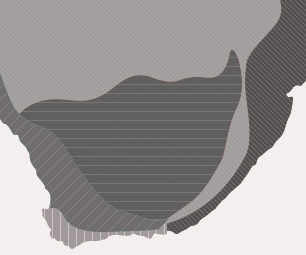
Euryops abrotanifolius (L.) DC.
Family:
Common names: lace-leaf euryops, mountain resin bush (Eng.); bergharpuisbos, geelmagriet (Afr.)
Plant Attributes:
Plant Type:
SA Distribution:
Soil type:
Flowering season:
PH:
Flower colour:
Aspect:
Gardening skill:
Special Features:
Horticultural zones

Euryops annae E.Phillips
Family:
Common names: small euryops, qoqolosi bush (Eng.); kleinbitterharpuisbos, bitterharpuisbos (Afr.); sehlakoana se senyenyane, sehalahala sa qoqolosi (Sesotho/Southern Sotho)
Plant Attributes:
Plant Type:
SA Distribution:
Soil type:
Flowering season:
PH:
Flower colour:
Aspect:
Gardening skill:
Special Features:
Horticultural zones

Euphorbia tirucalli L.
Family:
Common names: pencil plant, rubber-hedge euphorbia (Eng.); kraalmelkbos (Afr.)
SA Tree No: 355
Plant Attributes:
Plant Type:
SA Distribution:
Soil type:
Flowering season:
PH:
Flower colour:
Aspect:
Gardening skill:
Special Features:
Horticultural zones

Euryops chrysanthemoides (DC.) B. Nord.
Family:
Common names: golden daisy bush, daisy bush, resin bush (Eng.), geelmadeliefiebos, geelmargriet, harpuisbos (Afr.) (= Gamolepis chrysanthemoides DC.)
Plant Attributes:
Plant Type:
SA Distribution:
Soil type:
Flowering season:
PH:
Flower colour:
Aspect:
Gardening skill:
Special Features:
Horticultural zones

Euryops pectinatus (L.) Cass.
Family:
Common names: woolly resin bush, golden euryops, golden daisy bush (Eng.), wolharpuisbos (Afr.)
Plant Attributes:
Plant Type:
SA Distribution:
Soil type:
Flowering season:
PH:
Flower colour:
Aspect:
Gardening skill:
Special Features:
Horticultural zones

Euphorbia mauritanica L. var. mauritanica
Family:
Common names: yellow milk bush, golden spurge (Eng.); geelmelkbos, beesmelkbos, gifmelkbos, kaalmelkbos, kleinmelkbos (Afr.)
Plant Attributes:
Plant Type:
SA Distribution:
Soil type:
Flowering season:
PH:
Flower colour:
Aspect:
Gardening skill:
Special Features:
Horticultural zones

Euphorbia virosa Willd.
Family:
Common names: poison euphorbia (Eng.); Boesmansgif, boomgif, gifboom, noors, melkbos, naboom ( Afr.); nhlangaume (Shangana)
Plant Attributes:
Plant Type:
SA Distribution:
Soil type:
Flowering season:
PH:
Flower colour:
Aspect:
Gardening skill:
Special Features:
Horticultural zones

Euphorbia barnardii A.C.White, R.A.Dyer & B.Sloane
Family:
Common names: mokgwakgwatha (Pedi)
Plant Attributes:
Plant Type:
SA Distribution:
Soil type:
Flowering season:
PH:
Flower colour:
Aspect:
Gardening skill:
Special Features:
Horticultural zones

Euphorbia L.
Family:
Common names: spurges, euphorbias
Species
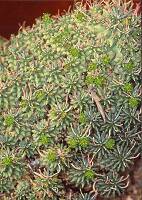
Euphorbia multiceps Hermann Wilhelm Rudolf Marloth discovered this very distinctive "manyheaded" Euphorbia in 1904 in the Laingsburg district. Not easily confused with any other species of Euphorbia, E. multiceps has a tall, conical main stem up to 600 mm high and 250 mm diam. at the base. The stem is covered with numerous horizontally spreading branches up to 75 mm long, decreasing upwards. Sharp-pointed, thick spines or modified peduncles arise from the stem and branches. Inflorescences are solitary at the tip of branches; glands light green.
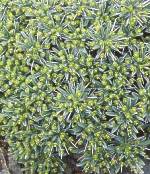
Euphorbia eustachei
Discovered in 1910 near Matjesfontein by Charles Eustace Pillans, then Director in the Cape Government service and keen collector of Cape succulents. A unisexual, spiny, dwarf shrub, built up consisting of many short, crowded branches, forms a neat pincushion, 150 mm high and 300 mm or more in diam. Spines or modified peduncles are solitary, up to 50 mm long, ascending and rigid. Leaves are deciduous, up to 40 mm long and minutely hairy. The cyathium is solitary and produced near the apex. The involucre is larger in the male plants, glabrous or minutely hairy, with 5 pale-yellowish glands.
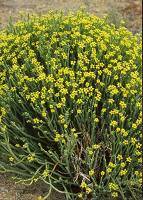
Euphorbia mauritanica
Euphorbia mauritanica was introduced into cultivation in Europe at or before the beginning of the 18th century and was believed to have originated in 'Mauritanica' in northwest Africa. A rounded shrub, densely branched, usually 1 m high, sometimes up to 2 m in height and usually wider in diam. Branches are cylindrical, fleshy, marked with alternate leaf scars. Leaves are deciduous, crowded on the youngest branches. Inflorescences consist of a male cyathium surrounded by 5 to 7 bisexual cyathia on a short terminal branch. Glands 5-8, bright yellow. Pistillate flower exserted from the involucre on a curved pedicel. One of the most widespread species but especially dominant in the Northern Cape.
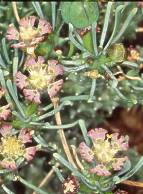
Euphorbia pentops
This species was described by White, Dyer & Sloane in 1941 from plants collected in 1930 by Hans Herre. The name translates as 'Euphorbia with five eyes' referring to the distinctive appearance of the involucral gland. Main stem stout, partly below ground. Branches numerous, short, with persistent peduncles. Cyathia solitary, arising from the axils of tubercles. Involucre cup-shaped, green with 5 glands and deeply laciniate lobes. The margins of the gland are divided into processes with the upper surface grayish or pinkish pubescent, except for the glossy green spot at the base of the gland.
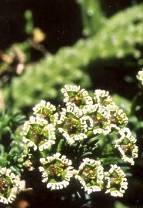
Euphorbia caput-medusae
'Medusa's head from the Cape ' aptly describes this species with multiple serpent-like stems arising from a short caudex (thick, woody stem). It was introduced into the Botanic Garden in Amsterdam in about 1700. Still plentiful near Cape Town where it occurs in deep sand or rocky outcrops on the coast. Plant often exceeding 1 m in diam., partly buried in the ground, covered with numerous crowded branches, spineless but with persistent remains of the peduncles. Cyathia solitary, produced in clusters at the apex of branches, peduncles up to 10 mm long; involucre broadly cup-shaped, 12 mm or more in diam., with 5 glands and 5 lobes; glands palmately divided into 3 to 6 linear processes, the undivided portion green and pitted and processes white. Pistillate flower slightly exserted beyond the lobes of the involucre.
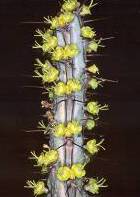
Euphorbia louwii
Named in 1980 by Larry Leach after Dr W.J. Louw who found it near Marken in Limpopo. Province. The 5-7-angular stem and the additional spine (nearly always present) distinguish this species from other similar species.
Euphorbia louwii is a spiny, shrubby species up to 1 m high, branching freely from the base, secondary branches sparse above. Branches greenish blue, 5-7-angled to subcylindric. Spine shields discontinuous and up to 10 mm long, bearing 5 slender spines, paired and the basal one is solitary and minute. Inflorescence with a horizontally arranged cyme (each flower is formed at the tip of a growing axis) of three cyathia, often additional ones arise in axils of bracts supporting lateral cyathia; peduncle short. Involucre funnel-shaped; glands 5, yellowish green.

Euphorbia waterbergensis
This species was first discovered by Mr Allan Lever in 1940 but Dyer described it only in 1951 when Dr L.E. Codd and Mr J. Ehrens made comprehensive collections. A spiny, succulent shrub, up to 1.5 m or occasionally more. Main stem suppressed, branching near ground level. Branches dark green or glaucous green, more or less erect, about 25 mm in diam., segmented into 20 to 200 mm long segments; 4-6-angled; angles furnished with paired spines on a continuous, horny gray margin, 1.5-2.0 mm broad. Spines in pairs, 5 mm long; prickles above spines rudimentary or absent. Cymes of 3-5 cyathia developed from the flowering eye just above the pair of spines; central cyathium male and developing first, with 2, 3 or 4 bisexual cyathia at right angles to the main axis. Cyathia glabrous with glands 5, contiguous, yellow, or light green. Capsules subglobose, reddish brown.E. waterbergensis is restricted to the northwestern foothills of the Waterberg Mountain Range. Conservation status: Vulnerable. Legally protected in Limpopo.
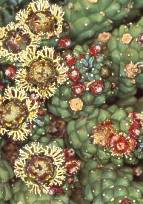
Euphorbia ramiglans
Discovered by Harry Bolus in 1883 but was only relatively recently rediscovered around Port Nolloth and Alexander Bay. Main stem stout, partly below ground, up to 200 mm high and 500 mm in diam. Branches numerous, up to 200 mm long, with peduncles rarely persistent. Cyathia solitary, arising from the axils of tubercles. Involucre cup-shaped; glands 5, green with 4-6, whitish, finely branching processes.
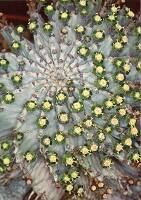
Euphorbia horrida
This attractive but rare form of Euphorbia horrida is one of several forms known from Jansenville in the Eastern Cape to Oudtshoorn in the Western Cape. This form is often seen in nurseries. The specific epithet means bristling, referring to the formidable rows of spines up to 40 mm long. Spiny succulent shrub, forming irregular clumps up to 1.5 m high. Branches erect, cylindrical, 100 to 150 mm thick, angles 10 to 20, wing-like, prominent. Spines or modified peduncles up to 40 mm long, very rigid. Cyathia solitary, pedunculate. Involucre finely hairy with 5 glands and 5 large lobes. Glands green or purple.
Plant Attributes:
Plant Type:
SA Distribution:
Soil type:
Flowering season:
PH:
Flower colour:
Aspect:
Gardening skill:
Special Features:
Horticultural zones






Rate this article
Article well written and informative
Rate this plant
Is this an interesting plant?
Login to add your Comment
Back to topNot registered yet? Click here to register.